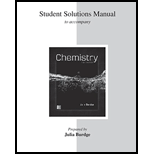
Concept explainers
Interpretation:
The elements that can be combined with silicon to form a semiconductor are to be indicated.
Concept introduction:
Semiconductors are the solids thathave a conductivity between those of conductors and insulators.
In a semiconductor, the gap between the conduction band and the valence band is small, so the electrons may jump from valence band to conduction band.
Conduction band: The conduction band is the band of electron orbitals that electrons can jump up into from the valence band when excited.
Valence band: The valence band is the band of electron orbitals that electrons can jump out of, moving into the conduction band when excited.
A Dopant, also called a doping agent, is a trace impurity element that is inserted into a substance (in very low concentrations) to alter the electrical or optical properties of the substance.
Doing: Addition of dopant is doping.
n-Type semiconductor: A semiconductor that has been doped with electron donor atoms is called an n-type semiconductor.
p-Type semiconductor: A semiconductor that has been doped with electron acceptor atoms is called a p-type semiconductor.
Want to see the full answer?
Check out a sample textbook solution
Chapter 23 Solutions
Student Solutions Manual for Chemistry
- 8.96 A business manager wants to provide a wider range of p- and n-type semiconductors as a strategy to enhance sales. You are the lead materials engineer assigned to communicate with this manager. How would you explain why there are more ways to build a p-type semiconductor from silicon than there are ways to build an n-type semiconductor from silicon?arrow_forwardCite and explain three reasons why ferrous alloys are used so extensively.arrow_forwardFor each of the following pairs of semiconductors, pick which one would have the larger bandgap. Explain your answer. i. ZnS and ZnSe ii. Si and AlP iii. GaN and InParrow_forward
- How are metals used as semiconductors refined? What is the principle of the method used?arrow_forwardIn which case is the correct type of impurity semiconductors given? Ga joined Ge, As joined Ge, Si joined Ge A. p-type, n-type, n-typeB. n-type, n-type, p-typeC. p-type, p-type, n-typeD. p-type, n-type, noneE. p-type, none, n-typearrow_forwardIndicate which of the following statements are true with regard to semiconductors. (a) elemental semiconductors are made of metalloids (b) semiconductors have a band gap that is greater than 3.5 eV (c) doping a semiconductor with a few ppm of a p block element increases the conductivity of that material by a million fold (d) compound semiconductors must contain at least one metalloid elementarrow_forward
 Chemistry & Chemical ReactivityChemistryISBN:9781337399074Author:John C. Kotz, Paul M. Treichel, John Townsend, David TreichelPublisher:Cengage Learning
Chemistry & Chemical ReactivityChemistryISBN:9781337399074Author:John C. Kotz, Paul M. Treichel, John Townsend, David TreichelPublisher:Cengage Learning Chemistry & Chemical ReactivityChemistryISBN:9781133949640Author:John C. Kotz, Paul M. Treichel, John Townsend, David TreichelPublisher:Cengage Learning
Chemistry & Chemical ReactivityChemistryISBN:9781133949640Author:John C. Kotz, Paul M. Treichel, John Townsend, David TreichelPublisher:Cengage Learning Principles of Modern ChemistryChemistryISBN:9781305079113Author:David W. Oxtoby, H. Pat Gillis, Laurie J. ButlerPublisher:Cengage Learning
Principles of Modern ChemistryChemistryISBN:9781305079113Author:David W. Oxtoby, H. Pat Gillis, Laurie J. ButlerPublisher:Cengage Learning Chemistry for Engineering StudentsChemistryISBN:9781337398909Author:Lawrence S. Brown, Tom HolmePublisher:Cengage Learning
Chemistry for Engineering StudentsChemistryISBN:9781337398909Author:Lawrence S. Brown, Tom HolmePublisher:Cengage Learning Chemistry: The Molecular ScienceChemistryISBN:9781285199047Author:John W. Moore, Conrad L. StanitskiPublisher:Cengage Learning
Chemistry: The Molecular ScienceChemistryISBN:9781285199047Author:John W. Moore, Conrad L. StanitskiPublisher:Cengage Learning





